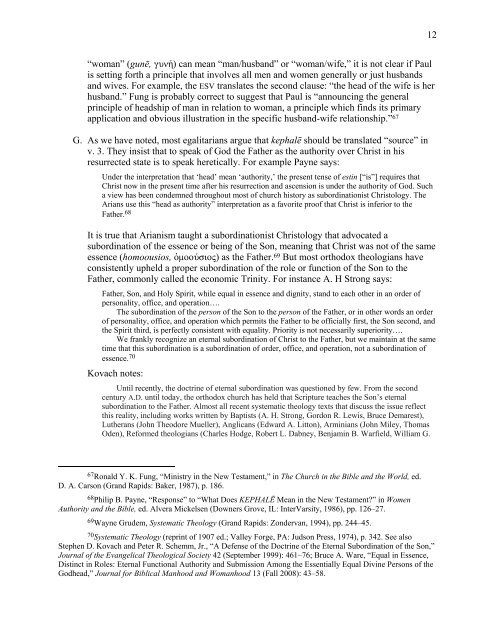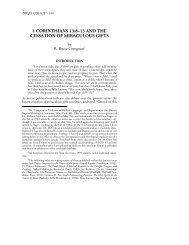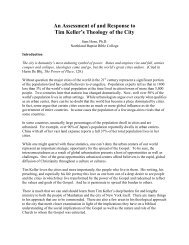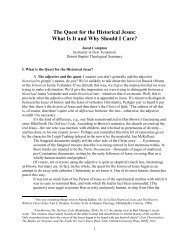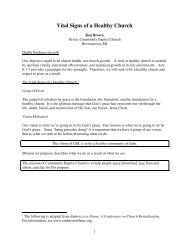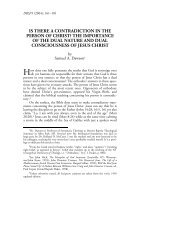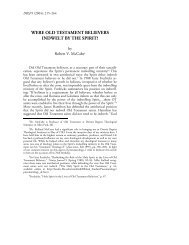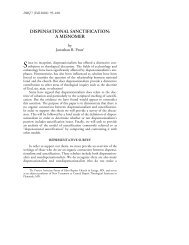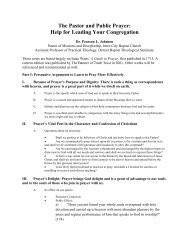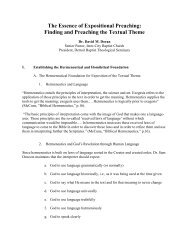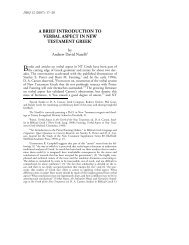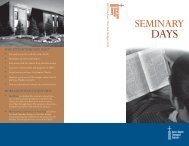Combs, Role of Women in the Church - Detroit Baptist Theological ...
Combs, Role of Women in the Church - Detroit Baptist Theological ...
Combs, Role of Women in the Church - Detroit Baptist Theological ...
Create successful ePaper yourself
Turn your PDF publications into a flip-book with our unique Google optimized e-Paper software.
12“woman” (gunē, γυνή) can mean “man/husband” or “woman/wife,” it is not clear if Paulis sett<strong>in</strong>g forth a pr<strong>in</strong>ciple that <strong>in</strong>volves all men and women generally or just husbandsand wives. For example, <strong>the</strong> ESV translates <strong>the</strong> second clause: “<strong>the</strong> head <strong>of</strong> <strong>the</strong> wife is herhusband.” Fung is probably correct to suggest that Paul is “announc<strong>in</strong>g <strong>the</strong> generalpr<strong>in</strong>ciple <strong>of</strong> headship <strong>of</strong> man <strong>in</strong> relation to woman, a pr<strong>in</strong>ciple which f<strong>in</strong>ds its primaryapplication and obvious illustration <strong>in</strong> <strong>the</strong> specific husband-wife relationship.” 67G. As we have noted, most egalitarians argue that kephalē should be translated “source” <strong>in</strong>v. 3. They <strong>in</strong>sist that to speak <strong>of</strong> God <strong>the</strong> Fa<strong>the</strong>r as <strong>the</strong> authority over Christ <strong>in</strong> hisresurrected state is to speak heretically. For example Payne says:Under <strong>the</strong> <strong>in</strong>terpretation that ‘head’ mean ‘authority,’ <strong>the</strong> present tense <strong>of</strong> est<strong>in</strong> [“is”] requires thatChrist now <strong>in</strong> <strong>the</strong> present time after his resurrection and ascension is under <strong>the</strong> authority <strong>of</strong> God. Sucha view has been condemned throughout most <strong>of</strong> church history as subord<strong>in</strong>ationist Christology. TheArians use this “head as authority” <strong>in</strong>terpretation as a favorite pro<strong>of</strong> that Christ is <strong>in</strong>ferior to <strong>the</strong>Fa<strong>the</strong>r. 68It is true that Arianism taught a subord<strong>in</strong>ationist Christology that advocated asubord<strong>in</strong>ation <strong>of</strong> <strong>the</strong> essence or be<strong>in</strong>g <strong>of</strong> <strong>the</strong> Son, mean<strong>in</strong>g that Christ was not <strong>of</strong> <strong>the</strong> sameessence (homoousios, ὀµοούσιος) as <strong>the</strong> Fa<strong>the</strong>r. 69 But most orthodox <strong>the</strong>ologians haveconsistently upheld a proper subord<strong>in</strong>ation <strong>of</strong> <strong>the</strong> role or function <strong>of</strong> <strong>the</strong> Son to <strong>the</strong>Fa<strong>the</strong>r, commonly called <strong>the</strong> economic Tr<strong>in</strong>ity. For <strong>in</strong>stance A. H Strong says:Fa<strong>the</strong>r, Son, and Holy Spirit, while equal <strong>in</strong> essence and dignity, stand to each o<strong>the</strong>r <strong>in</strong> an order <strong>of</strong>personality, <strong>of</strong>fice, and operation….The subord<strong>in</strong>ation <strong>of</strong> <strong>the</strong> person <strong>of</strong> <strong>the</strong> Son to <strong>the</strong> person <strong>of</strong> <strong>the</strong> Fa<strong>the</strong>r, or <strong>in</strong> o<strong>the</strong>r words an order<strong>of</strong> personality, <strong>of</strong>fice, and operation which permits <strong>the</strong> Fa<strong>the</strong>r to be <strong>of</strong>ficially first, <strong>the</strong> Son second, and<strong>the</strong> Spirit third, is perfectly consistent with equality. Priority is not necessarily superiority….We frankly recognize an eternal subord<strong>in</strong>ation <strong>of</strong> Christ to <strong>the</strong> Fa<strong>the</strong>r, but we ma<strong>in</strong>ta<strong>in</strong> at <strong>the</strong> sametime that this subord<strong>in</strong>ation is a subord<strong>in</strong>ation <strong>of</strong> order, <strong>of</strong>fice, and operation, not a subord<strong>in</strong>ation <strong>of</strong>essence. 70Kovach notes:Until recently, <strong>the</strong> doctr<strong>in</strong>e <strong>of</strong> eternal subord<strong>in</strong>ation was questioned by few. From <strong>the</strong> secondcentury A.D. until today, <strong>the</strong> orthodox church has held that Scripture teaches <strong>the</strong> Son’s eternalsubord<strong>in</strong>ation to <strong>the</strong> Fa<strong>the</strong>r. Almost all recent systematic <strong>the</strong>ology texts that discuss <strong>the</strong> issue reflectthis reality, <strong>in</strong>clud<strong>in</strong>g works written by <strong>Baptist</strong>s (A. H. Strong, Gordon R. Lewis, Bruce Demarest),Lu<strong>the</strong>rans (John Theodore Mueller), Anglicans (Edward A. Litton), Arm<strong>in</strong>ians (John Miley, ThomasOden), Reformed <strong>the</strong>ologians (Charles Hodge, Robert L. Dabney, Benjam<strong>in</strong> B. Warfield, William G.67 Ronald Y. K. Fung, “M<strong>in</strong>istry <strong>in</strong> <strong>the</strong> New Testament,” <strong>in</strong> The <strong>Church</strong> <strong>in</strong> <strong>the</strong> Bible and <strong>the</strong> World, ed.D. A. Carson (Grand Rapids: Baker, 1987), p. 186.68 Philip B. Payne, “Response” to “What Does KEPHALĒ Mean <strong>in</strong> <strong>the</strong> New Testament?” <strong>in</strong> <strong>Women</strong>Authority and <strong>the</strong> Bible, ed. Alvera Mickelsen (Downers Grove, IL: InterVarsity, 1986), pp. 126–27.69 Wayne Grudem, Systematic Theology (Grand Rapids: Zondervan, 1994), pp. 244–45.70 Systematic Theology (repr<strong>in</strong>t <strong>of</strong> 1907 ed.; Valley Forge, PA: Judson Press, 1974), p. 342. See alsoStephen D. Kovach and Peter R. Schemm, Jr., “A Defense <strong>of</strong> <strong>the</strong> Doctr<strong>in</strong>e <strong>of</strong> <strong>the</strong> Eternal Subord<strong>in</strong>ation <strong>of</strong> <strong>the</strong> Son,”Journal <strong>of</strong> <strong>the</strong> Evangelical <strong>Theological</strong> Society 42 (September 1999): 461–76; Bruce A. Ware, “Equal <strong>in</strong> Essence,Dist<strong>in</strong>ct <strong>in</strong> <strong>Role</strong>s: Eternal Functional Authority and Submission Among <strong>the</strong> Essentially Equal Div<strong>in</strong>e Persons <strong>of</strong> <strong>the</strong>Godhead,” Journal for Biblical Manhood and Womanhood 13 (Fall 2008): 43–58.


